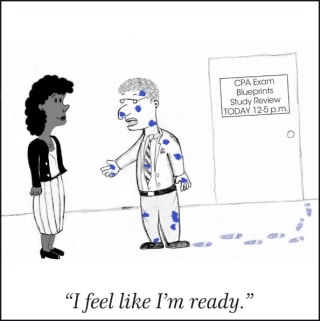There are many things you don’t do unless you have the proper materials, information or training. You just don’t.
Construction crews don’t build a 100-story skyscraper without a structural design plan. An amateur runner doesn’t jump into the New York City Marathon without having logged a substantial number of miles and completing a qualifying race. And neither you nor I can simply hop into a rocket and head off for a leisurely space walk without extensive training.
The point is, as a CPA candidate, when you finally set foot in a testing center, you should have thoroughly studied and become familiar with the Exam’s content. One of the best ways to do this: study the AICPA’s CPA Examination Blueprints.

As the exam’s developer, the AICPA publishes the Exam Blueprints, which is an in-depth, section-by-section guide for candidates preparing to test. If you’re planning to sit for the Exam and said to yourself, What are the Blueprints? you need to dig in right away because you’ll:
1) Know specific content that may be tested and what you’ll be expected to do.
There’s no other way to say it: You want to know what’s on the Exam. It’s not a secret. The Exam Blueprints say it all. For each section, content eligible for testing is presented in organized charts with sub categories that break it down even further into groups and topics.
2) Discover approximately 600 tasks that may appear on the CPA Exam.
The best part of the Exam Blueprints is, in addition to providing the eligible test content within each section, they also provide approximately 600 tasks a newly licensed CPA should be able to do in relation to that content. While the list of tasks is not all-inclusive, each of the Blueprints’ sections offers greater clarity with regard to the types of tasks you may be presented with when testing.
3) See the skill level for related content.
The Exam is focused on testing higher-order cognitive skills, which are essential to your effectiveness as a future CPA. The Exam Blueprints’ introduction breaks down the approximate percentage of content you’ll see in each section at a particular skill level. Topic-by-topic, the Exam Blueprints also show the skill level at which you’ll be assessed and the task associated with it. From the most basic remembering and understanding to the more complex evaluation-level items, you’ll know what to expect when it comes to the skill level at which items are tested.
4) Learn the content allocation for each section.
One of the big questions for candidates is how much coverage a specific topic will get on the Exam. Within each section, the content allocation is presented by topic area. Along with section overviews of content areas, this helps you understand what type of content will receive greater focus within the section.
5) Get a full list of reference materials for each CPA Exam section.
At the end of each section’s introduction, you’ll be presented with a bulleted list of references such as federal regulations or guidelines. Familiarization with these references will help you prepare, as they serve as the basis for the tasks included in each section.
As you can see, these are all good reasons why the Exam Blueprints should be your go-to resource for studying. When I took the CPA Exam, candidates didn’t have access to something that brought as much clarity to the Exam’s content as these Blueprints. They should be a welcome addition to your study arsenal.
While I understand each candidate has a different style and strategy for how to prepare, the Blueprints are a must for the entire Exam journey. Just like the runner entering that big 26.2-mile run, you need to prepare. Start with the CPA Examination Blueprints.
Henrietta Eve, CPA, is Lead Manager of Product Development for the Association of International Certified Professional Accountants.
This article originally appeared on AICPA Insights.
Want more tips for success on the CPA Exam? Subscribe to Passing Insights, the Surgent CPA Review blog.




